Homer: A Guide to Sculptural Types
Correlate the sources mentioned in the guide to those listed in the margin using the mouse.
William Wallis
There are five sculptural types that are generally considered to depict Homer. Of these, only two can be identified securely from external evidence.
The Epimenides Type Homer 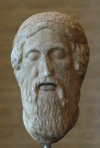 occurs in several Roman examples (Boehringer-Boehringer 1939: 19-41; Richter 1965: 47-48). None show more than head, neck and shoulders. Their style suggests a prototype of mid-fifth century (Richter 1965), and the angle at which the head meets the neck suggests a standing figure, whose head tilts slightly to the right. It has been suggested that such a portrait of Homer is seen and described by Christodorus in his Ekphrasis A.P. 2.1.311 (Zanker 1995: 19; Bassett 2004: 173-175). Noteworthy features of this type are the closed-eyelids, variously interpreted as sleep – hence the identification as Epimenides, a Cretan seer and singer who slept for fifty-seven years (Esdaile 1912: 302-03) – or blindness. The eyes seem closed but not at rest (the two lids meet at the eye’s equator): this feature may have been the only available means of representing blindness in early Classical art (given its reluctance to depict physical disability). The portrait may then reflect a long tradition in which Homer is depicted as blind Homer: A Guide to Selected Sources (Graziosi 2002: 138-63). Also of interest is the fillet which binds the poet’s head. Though there is no conclusive evidence, this seems to form part of the costume of a poet (Dillon 2006: 124-25). The poet’s coiffure is full and tidy. Of note is how the receding brow is covered by two locks of hair drawn from the back of the head to where they are tied centrally on the forehead, a style associated with dignified old age. On the basis of its date and style, it has been proposed that the prototype formed part of the Micythos dedication at Olympia. Micythos, an exiled Rhegean then living in Tegea, dedicated several groups of statues Paus. 5.26.2 (by Argive sculptors Glaucus and Dionysius) at Olympia, including Gods, personified abstracts, and the poets Homer and Hesiod (Frazer 1898: 646-48; Richter 1965; Zanker 1995: 20-21).
occurs in several Roman examples (Boehringer-Boehringer 1939: 19-41; Richter 1965: 47-48). None show more than head, neck and shoulders. Their style suggests a prototype of mid-fifth century (Richter 1965), and the angle at which the head meets the neck suggests a standing figure, whose head tilts slightly to the right. It has been suggested that such a portrait of Homer is seen and described by Christodorus in his Ekphrasis A.P. 2.1.311 (Zanker 1995: 19; Bassett 2004: 173-175). Noteworthy features of this type are the closed-eyelids, variously interpreted as sleep – hence the identification as Epimenides, a Cretan seer and singer who slept for fifty-seven years (Esdaile 1912: 302-03) – or blindness. The eyes seem closed but not at rest (the two lids meet at the eye’s equator): this feature may have been the only available means of representing blindness in early Classical art (given its reluctance to depict physical disability). The portrait may then reflect a long tradition in which Homer is depicted as blind Homer: A Guide to Selected Sources (Graziosi 2002: 138-63). Also of interest is the fillet which binds the poet’s head. Though there is no conclusive evidence, this seems to form part of the costume of a poet (Dillon 2006: 124-25). The poet’s coiffure is full and tidy. Of note is how the receding brow is covered by two locks of hair drawn from the back of the head to where they are tied centrally on the forehead, a style associated with dignified old age. On the basis of its date and style, it has been proposed that the prototype formed part of the Micythos dedication at Olympia. Micythos, an exiled Rhegean then living in Tegea, dedicated several groups of statues Paus. 5.26.2 (by Argive sculptors Glaucus and Dionysius) at Olympia, including Gods, personified abstracts, and the poets Homer and Hesiod (Frazer 1898: 646-48; Richter 1965; Zanker 1995: 20-21).
The Modena Type Homer 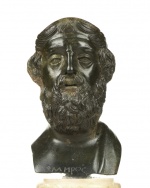 occurs in two small bronze busts. This type can be stylistically dated to the early fourth century (Boehringer-Boehringer 1939: 131-135; Richter 1965: 141-42). There is considerable difference in the quality of the two examples. The example in Modena is the finer by far, and identifies itself by the inscription ΟΜΗΡΟC, ‘Homer’. In this type the eyes are clearly open and the pupils discernible. The poet wears a taenia fillet and the arrangement of the hair is similar to the Epimenides Type Homer, though now the portrait has a centrally parted fringe that passes over the fillet before being tucked through it to hang down over the ears. The beard is shorter and thicker than in the earlier type. The miniature scale of these examples might reflect a different display context for these pieces (a table, niche or mantel, rather than a herm, for example) but that two such different examples should be exactly the same size perhaps suggests that their prototype was a miniature also.
occurs in two small bronze busts. This type can be stylistically dated to the early fourth century (Boehringer-Boehringer 1939: 131-135; Richter 1965: 141-42). There is considerable difference in the quality of the two examples. The example in Modena is the finer by far, and identifies itself by the inscription ΟΜΗΡΟC, ‘Homer’. In this type the eyes are clearly open and the pupils discernible. The poet wears a taenia fillet and the arrangement of the hair is similar to the Epimenides Type Homer, though now the portrait has a centrally parted fringe that passes over the fillet before being tucked through it to hang down over the ears. The beard is shorter and thicker than in the earlier type. The miniature scale of these examples might reflect a different display context for these pieces (a table, niche or mantel, rather than a herm, for example) but that two such different examples should be exactly the same size perhaps suggests that their prototype was a miniature also.
The Apollonius of Tyana Type Homer 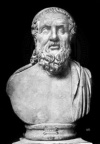 occurs in between sixteen (by Boehringer’s count) or thirteen (by Richter’s count) examples. Unluckily, none carries an inscription (Boehringer-Boehringer 1939: 42-72; Richter 1965: 48-50). The type is life-sized, and no copy shows more than the head, neck and shoulders. There is considerable variation among examples, but the majority have enough in common to discern a common object of emulation. This type can be dated stylistically to the very beginning of the third century (Richter 1965). Its identification as Homer is based on several inconclusive considerations. First, the number of examples testifies to the popularity of the subject, and Homer of course was popular. The figure is once again accoutred with a fillet (though much thicker than in earlier types). Finally this type is thought to resemble both the head on an inscribed coin from Amastris in Paphlagonia
occurs in between sixteen (by Boehringer’s count) or thirteen (by Richter’s count) examples. Unluckily, none carries an inscription (Boehringer-Boehringer 1939: 42-72; Richter 1965: 48-50). The type is life-sized, and no copy shows more than the head, neck and shoulders. There is considerable variation among examples, but the majority have enough in common to discern a common object of emulation. This type can be dated stylistically to the very beginning of the third century (Richter 1965). Its identification as Homer is based on several inconclusive considerations. First, the number of examples testifies to the popularity of the subject, and Homer of course was popular. The figure is once again accoutred with a fillet (though much thicker than in earlier types). Finally this type is thought to resemble both the head on an inscribed coin from Amastris in Paphlagonia 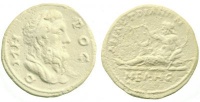 (Esdaile 1913: 317-21), and an inscribed figurine depicted in Fulvio Orsini’s Imagines et Elogia (1570)
(Esdaile 1913: 317-21), and an inscribed figurine depicted in Fulvio Orsini’s Imagines et Elogia (1570) 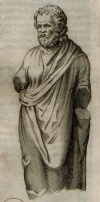 (Richter 1965), but now lost. The eyes of this type are open, but pupils are not incised in most examples. There is some variation in the treatment of the brow in examples of this type. However all have in common looser locks of hair, particularly at the back of the neck, where it is very long. Such a coiffure is uncommon at this date, occurring in only two other types, both of which are poets (Dillon 2002: 125). This type has been interpreted as looking benign and eager. Its appearance could be associated with the character of Odyssean Homer, as described by Longinus Longin. 9.13.
(Richter 1965), but now lost. The eyes of this type are open, but pupils are not incised in most examples. There is some variation in the treatment of the brow in examples of this type. However all have in common looser locks of hair, particularly at the back of the neck, where it is very long. Such a coiffure is uncommon at this date, occurring in only two other types, both of which are poets (Dillon 2002: 125). This type has been interpreted as looking benign and eager. Its appearance could be associated with the character of Odyssean Homer, as described by Longinus Longin. 9.13.
Were one to continue this analogy to Longinus’ descriptions of Homer, one might recognise Longinus’ 'Iliadic' Homer in a later Hellenistic portrait type: The Hellenistic Blind Type Homer 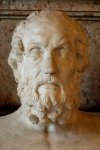 is by far the most famous type. It is reproduced by, among others, Rembrandt van Rijn, Ingres, and Korzhev. It also seems to have been the most popular type in antiquity: Richter (1965: 50-53) was able to track down twenty-two Roman examples; Boehringer and Boehringer (1939: 73-130) identify nineteen. There is considerable variation between examples, and many have a history of extensive and creative repair work. It is identified as Homer through the sheer number of copies, and through its characterisation (this is clearly a very famous blind man). It can be dated stylistically to the second century B.C. (Richter 1965) Again Homer wears a poetic fillet, and though his eyes are open, their expression (in particular the raised eyebrows and raised lower eyelids) implies that they do not see. This type has been considered highly expressive of both character (divine, fierce, venerable), and pathos (pained, searching, in the grip of poetic enthousiasmos) (Dillon 2006: 116,124). Its high ‘baroque’ drama perhaps reflects the epic nature of Homer’s poetry. The vividly depicted old age of the poet has been thought to reflect the antiquity of the poetry.
is by far the most famous type. It is reproduced by, among others, Rembrandt van Rijn, Ingres, and Korzhev. It also seems to have been the most popular type in antiquity: Richter (1965: 50-53) was able to track down twenty-two Roman examples; Boehringer and Boehringer (1939: 73-130) identify nineteen. There is considerable variation between examples, and many have a history of extensive and creative repair work. It is identified as Homer through the sheer number of copies, and through its characterisation (this is clearly a very famous blind man). It can be dated stylistically to the second century B.C. (Richter 1965) Again Homer wears a poetic fillet, and though his eyes are open, their expression (in particular the raised eyebrows and raised lower eyelids) implies that they do not see. This type has been considered highly expressive of both character (divine, fierce, venerable), and pathos (pained, searching, in the grip of poetic enthousiasmos) (Dillon 2006: 116,124). Its high ‘baroque’ drama perhaps reflects the epic nature of Homer’s poetry. The vividly depicted old age of the poet has been thought to reflect the antiquity of the poetry.
The ‘Apotheosis of Homer’ or ‘Archelaus Relief’ 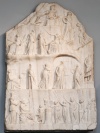 is probably a victory monument for a poet (depicted at the right hand side of the relief). It is inscribed with the name of its maker, Archelaos of Priene. The date of this object’s production is debated: opinions range from the late third century (Richter 1965: 54), to the late second century (Pinkwart 1965: 48-63). It depicts mount Helicon, at the top of which an enthroned Zeus and Mnemosyne exchange glances. In the two registers below are shown their daughters, the nine Muses, and possibly Apollo, playing a lyre in a cave (Pinkwart 1965: 78-82). The lowest register shows an architectural space defined by columns that support drapery. Within this space Chronos (Time) and Oikumene (the Inhabited World) crown an enthroned Homer who holds a sceptre and a scroll. Kneeling on either side of the poet are personifications of the Iliad and Odyssey. At the right of this scene, personifications of various genres of literature guide a bull to sacrifice on an altar before the poet, and lift up hands and torches in worship. Some have made out two mice at the foot of Homer’s throne, which could allude to the Batrachomyomachia, or Battle of Frogs and Mice, of supposed Homeric authorship. Chronos and Oikumene have been identified by some as portraits of Hellenistic rulers. Several suggestions have been made (Pinkwart 1965: 77), but the current orthodoxy is that they represent Ptolemy IV Philopator and Arsinoe III, founders of the Homer cult at Alexandria (Newby 2007). The presence together of poetry, royalty and memory hints at a Hesiodic reading for this relief: the Theogony makes much of the connection between poetry and royalty, and their shared dependence on the Muses, the children of Zeus and Mnemosyne, who share such a conspicuous moment in the upper register of this relief.
is probably a victory monument for a poet (depicted at the right hand side of the relief). It is inscribed with the name of its maker, Archelaos of Priene. The date of this object’s production is debated: opinions range from the late third century (Richter 1965: 54), to the late second century (Pinkwart 1965: 48-63). It depicts mount Helicon, at the top of which an enthroned Zeus and Mnemosyne exchange glances. In the two registers below are shown their daughters, the nine Muses, and possibly Apollo, playing a lyre in a cave (Pinkwart 1965: 78-82). The lowest register shows an architectural space defined by columns that support drapery. Within this space Chronos (Time) and Oikumene (the Inhabited World) crown an enthroned Homer who holds a sceptre and a scroll. Kneeling on either side of the poet are personifications of the Iliad and Odyssey. At the right of this scene, personifications of various genres of literature guide a bull to sacrifice on an altar before the poet, and lift up hands and torches in worship. Some have made out two mice at the foot of Homer’s throne, which could allude to the Batrachomyomachia, or Battle of Frogs and Mice, of supposed Homeric authorship. Chronos and Oikumene have been identified by some as portraits of Hellenistic rulers. Several suggestions have been made (Pinkwart 1965: 77), but the current orthodoxy is that they represent Ptolemy IV Philopator and Arsinoe III, founders of the Homer cult at Alexandria (Newby 2007). The presence together of poetry, royalty and memory hints at a Hesiodic reading for this relief: the Theogony makes much of the connection between poetry and royalty, and their shared dependence on the Muses, the children of Zeus and Mnemosyne, who share such a conspicuous moment in the upper register of this relief.
Finally, it is interesting that although Homer’s blindness and age (familiar from biographical sources) are present in some of these sculptures, none depict the poet as remotely beggarly (another ubiquitous theme of the written sources). It might be suggested that these portraits have in common that they primarily reflect the character of the poetry (far from beggarly), rather than embodying the character depicted in biographical accounts.
Bibliography
- Bassett, S. 2004. The Urban Image of Late Antique Constantinople. Cambridge.
- Boehringer, R. B. and Boehringer, E. 1939. Homer Bildnisse und Nachweise. Breslau.
- Clay, D. 2004. Archilochos Heros: The Cult of Poets in the Greek Polis. Cambridge, Mass.
- Dillon, S. 2006. Ancient Greek Portrait Sculpture: Contexts, Subjects, and Styles. Cambridge.
- Esdaile, K. A. 1912. ‘An Essay towards the Classification of Homeric Coin Types.’ JHS 32: 298-325.
- Frazer, J. G. 1898. Pausanias’s Description of Greece, vol. 3. London.
- Graziosi, B. 2002. Inventing Homer: The Early Reception of Epic. Cambridge.
- Newby, Z. 2007. ‘Reading the Archelaos Relief.’ In Z. Newby and R. Leader-Newby (eds.) 2007, Art and Inscriptions in the Ancient World. Cambridge: 156-178.
- Pinkwart, D. 1965. Das Relief des Archelaos von Priene und die “Musen des Philiskos”. Kallmünz.
- Richter, G. M. A. 1965. The Portraits of the Greeks, vol. 1. London.
- and Smith, R.R.R. 1984. The Portraits of the Greeks. Oxford.
- Schefold, K. and Bayard, A.-C. 1997. Die Bildnisse der Antiken Dichter, Redner und Denker. Basel.
- Zanker, P. 1995. The Mask of Socrates: The Image of the Intellectual in Antiquity. Trans. A. Shapiro. Berkeley.
